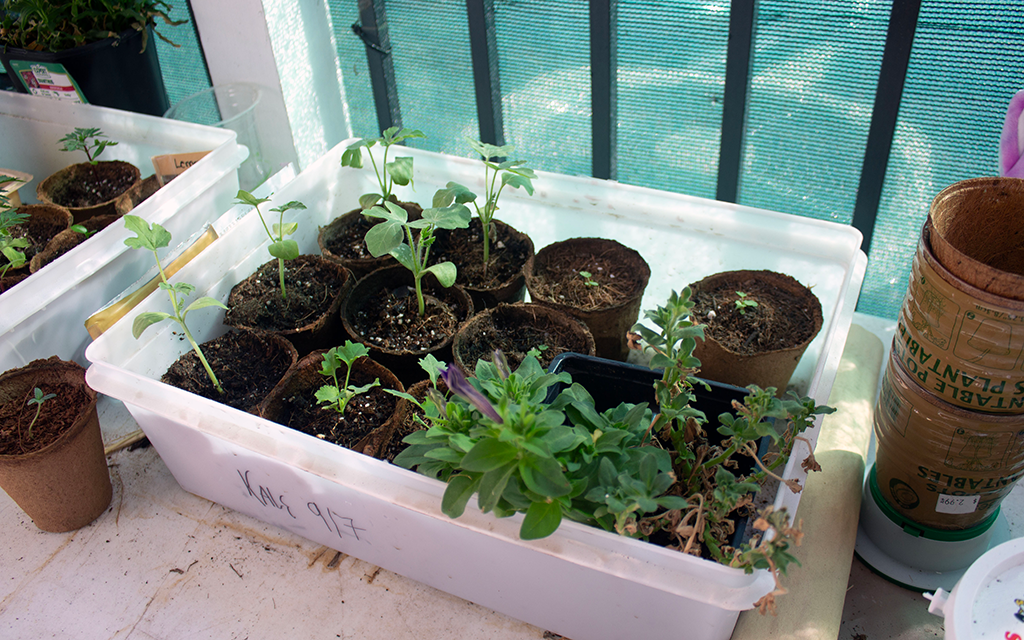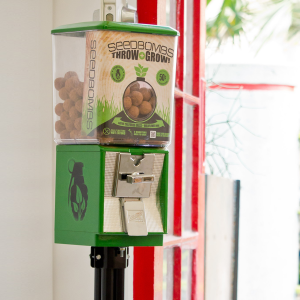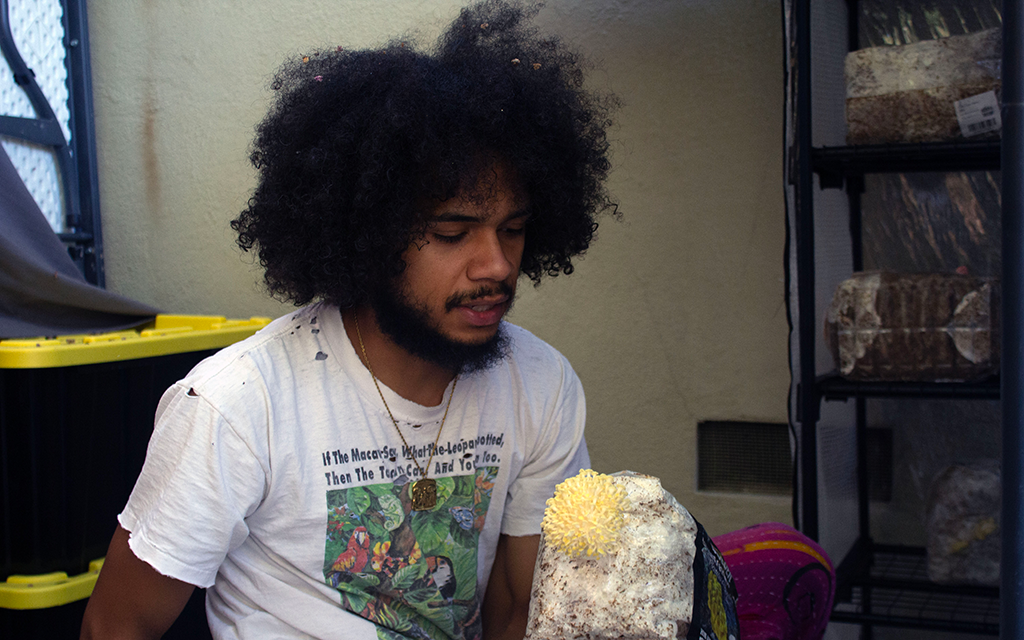LOS ANGELES – Amid the barren patches of dirt scattered throughout Los Angeles’ bustling streets, a movement for social change is taking root. Community gardens and local plants flourish in underused land, bringing much-needed green to the city’s concrete jungle.
Starting as a necessity for people who didn’t own land seeking to provide food for their communities, guerrilla gardening has evolved into a powerful tool for social rebellion and environmental activism.
Guerrilla gardening is a grassroots movement in which individuals grow plants in neglected or sometimes unauthorized spaces. The movement’s goals range from improving food security and beautifying urban landscapes to raising awareness about environmental issues.
Fostering food independence
William Padilla-Brown, founder and CEO of MycoSymbiotics, has sprouted into the LA scene, and he is teaching others how to reclaim the soil and question a life disconnected from the Earth. His gardening journey began with experimenting in his backyard, growing organic vegetables and mushrooms and learning from local permaculture experts.
Over time, this expanded into guerrilla gardening projects in his community. He started planting native plants and mushrooms in semi-wild areas, creating edible ecosystems that anyone could access, regardless of whether they owned land or had the resources to develop it.
“(I was) building up the community into a level of autonomy and becoming independent producers instead of dependent consumers,” Padilla-Brown said. “This is what I do with my life. It’s been really cool to see because it’s helping build the new realities that I want to live in.”

William Padilla-Brown restarts his backyard garden in Los Angeles using small samples of plants to teach his children about foraging and planting. (Photo by Brandelyn Clark/Cronkite News)
Guerrilla gardeners are returning the movement to its roots, using it to provide healthy food and equitable resources for underserved communities. They say this approach addresses immediate needs and fosters a sense of independence.
“I didn’t want to bring kids into this world if I didn’t see that there was an opportunity, a way to live that was different. … All of the times that we plant trees, all the mushrooms – it’s a seed into this crazy world of something that we can interact with … we can develop a relationship with when everything is … transforming so fast in front of us,” Padilla-Brown said.
His company is a center for mushroom cultivation and sustainability education. Padilla-Brown teaches through consultations and workshops and emphasizes permaculture, a philosophy that uses natural elements to create sustainable ways of life, from infrastructure to food growth.
“We live in a figurative desert that is a human-built environment. … If I want resources, I have to tap into the overlords to pay for it,” Padilla-Brown said. “How do I take the energy of the constructed environment around me and transform it into something that’s more prolific and abundant?”
Padilla-Brown’s “figurative desert” reflects a reality found in Los Angeles. A study by Loyola Marymount University found that nearly 1 million Californians live in food deserts, with 45% being low-income households. A food desert is usually found in low-income neighborhoods with limited access to healthy, affordable foods. These areas are surrounded by fast food chains, offering cheap and unhealthy options while fresh produce remains out of reach for many residents.
Empowering everyday gardeners
Kim Karlsrud and Daniel Phillips are the driving forces behind the Common Studio. Their creative practice focuses on socio-ecological spatial interventions, which means improving urban environments by addressing social needs and environmental issues.
The organization’s guerrilla gardening project, Greenaid – alongside nonprofit Chrysalis – aims to empower communities to create green space by making guerilla gardening accessible.
Created in the early 2010s, these coin-operated vending machines, decked in green paint, have an illustration of a grenade with a sprout.
“My dad had a side hobby with vending machines, and one day he was like … what’s your address? We woke up and we had two dozen vending machines at our little house. So we’re like, we’re gonna do something with these … We (were) very interested in guerrilla gardening,” Karlsrud said. “We managed to get all the materials together, and we turned that into seed bomb vending machines.”

Los Angeles-based guerrilla gardeners Kim Karlsrud and Daniel Phillips created the seed bomb vending machine, a creative initiative that offers native plant seeds to the community. (Photo courtesy of the Common Studio)
Within the nostalgic vending machines are seed bombs: balls of packed soil, clay and a mixture of native seeds. By tossing these seed bombs into vacant lots, sidewalk cracks or other neglected urban areas, anyone can quickly introduce native flora or food to their neighborhoods. The simplicity of the seed bombs not only enhances local ecosystems but welcomes the everyday gardener into the movement.
“People taking these little pockets of urban landscape and cultivating them, investing in them and caring for them – it might not be the huge meadow we associate with wild spaces in our mind. It’s definitely a first step to reclaiming urban space and getting involved with shaping it,” Karlsrud said.
Balancing solutions in the face of regulations
Supporters of guerrilla gardening argue that it offers holistic solutions to the city’s food desert problem and plays an essential role in improving air quality. By cultivating more plants, it helps reduce the city’s infamous smog.
In April, Los Angeles received its 25th consecutive F grade from the American Lung Association for air quality issues. The annual State of the Air report highlights the growing urgency to address these environmental challenges.
Karlsrud stressed the need for immediate action by residents.
“How do we address some of these big, seemingly impossible challenges in … accessible ways that can start now? Not with three years worth of planning and eight years worth of approvals,” Karlsrud said. “We wanted something immediate.”
Environmentalists are pushing for quicker solutions, hoping to address these issues urgently while city officials work to balance sustainability practices and upholding policies.
“The city only allows certain drought-tolerant and drought-resistant plants in the public right of way as part of its commitment to water conservation,” Oliver Hall from the Department of Public Works said in an email.
Guerilla gardeners often operate in this legal gray area. Gardening efforts will only be reviewed when the applicant submits two permits, the first through the Bureau of Engineering, according to the Bureau of Street Services.
This framework reflects the city’s dedication to managing its green spaces with sustainable practices. It also actively deters locals from planting in spaces left barren for extended periods.
Hall also noted that the Bureau of Street Services Investigation and Enforcement Division thoroughly investigates any violations, such as illegal planting or encroachment on public spaces.
These violations may result in imprisonment for up to six months and fines up to $1,000. This tension can spark larger social protests from activists wishing to reclaim the space.
As guerilla gardening and subtle activism continue to exist in metropolitan areas, the balance between legal compliance and community solutions remains a sensitive issue.
“We wanted to create something that gave people a way to take action right in their communities, to feel empowered, even if it’s just planting a seed in a patch of dirt. It’s about looking closer and seeing the potential in the little spaces around you,” Karlsrud said.

